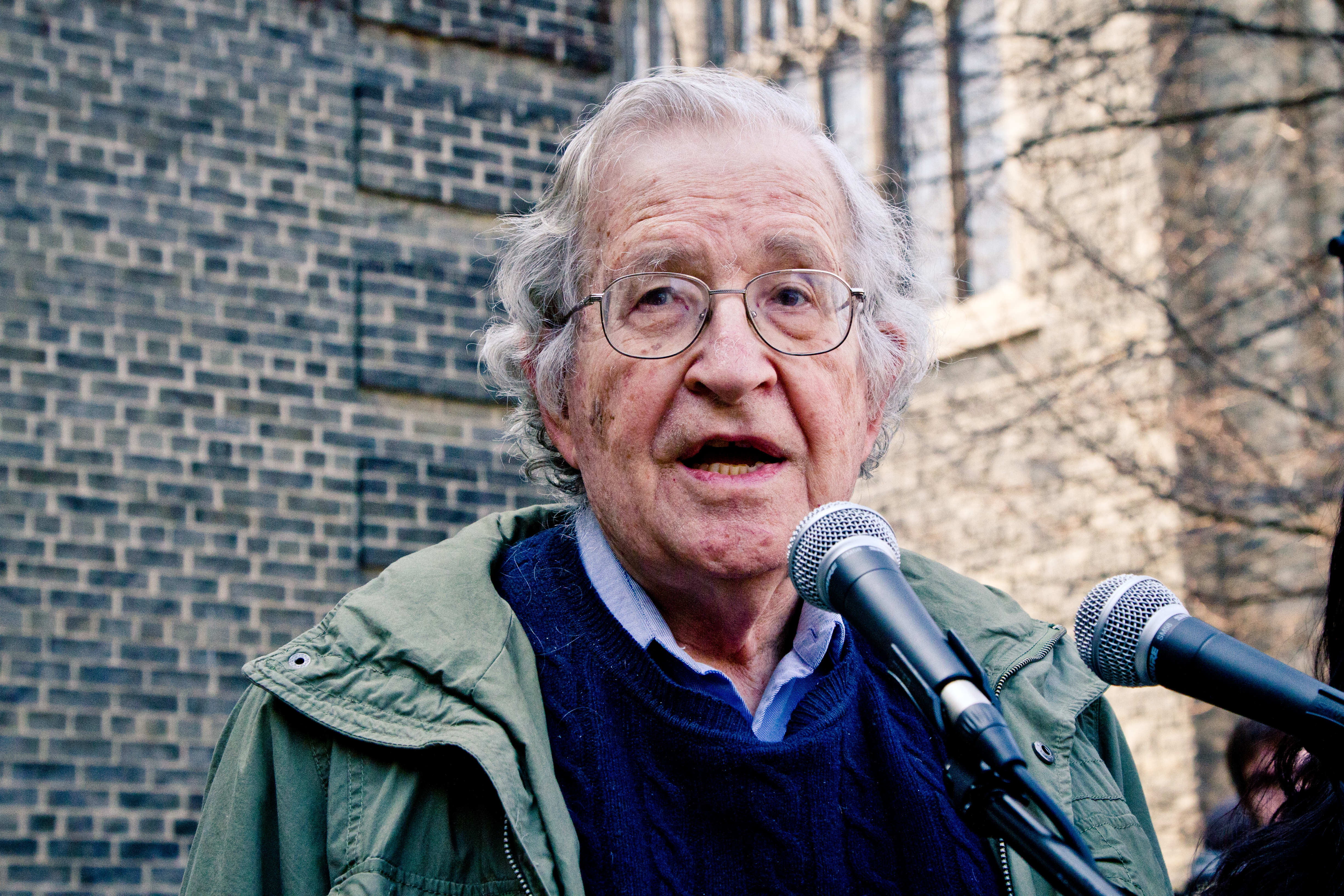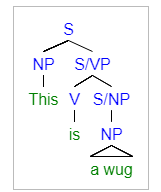|
Phrase-structure Grammar
The term phrase structure grammar was originally introduced by Noam Chomsky as the term for grammar studied previously by Emil Post and Axel Thue ( Post canonical systems). Some authors, however, reserve the term for more restricted grammars in the Chomsky hierarchy: context-sensitive grammars or context-free grammars. In a broader sense, phrase structure grammars are also known as ''constituency grammars''. The defining character of phrase structure grammars is thus their adherence to the constituency relation, as opposed to the dependency relation of dependency grammars. History In 1956, Chomsky wrote, "A phrase-structure grammar is defined by a finite vocabulary (alphabet) Vp, and a finite set Σ of initial strings in Vp, and a finite set F of rules of the form: X → Y, where X and Y are strings in Vp." Constituency relation In linguistics, phrase structure grammars are all those grammars that are based on the constituency relation, as opposed to the dependency relation asso ... [...More Info...] [...Related Items...] OR: [Wikipedia] [Google] [Baidu] |
Noam Chomsky
Avram Noam Chomsky (born December 7, 1928) is an American professor and public intellectual known for his work in linguistics, political activism, and social criticism. Sometimes called "the father of modern linguistics", Chomsky is also a major figure in analytic philosophy and one of the founders of the field of cognitive science. He is a laureate professor of linguistics at the University of Arizona and an institute professor emeritus at the Massachusetts Institute of Technology (MIT). Among the most cited living authors, Chomsky has written more than 150 books on topics such as linguistics, war, and politics. In addition to his work in linguistics, since the 1960s Chomsky has been an influential voice on the American Left, American left as a consistent critic of U.S. foreign policy, Criticism of capitalism, contemporary capitalism, and Corporate influence on politics in the United States, corporate influence on political institutions and the media. Born to Ashkenazi Jew ... [...More Info...] [...Related Items...] OR: [Wikipedia] [Google] [Baidu] |
Generalized Phrase Structure Grammar
Generalized phrase structure grammar (GPSG) is a framework for describing the syntax and semantics of natural languages. It is a type of constraint-based phrase structure grammar. Constraint based grammars are based around defining certain syntactic processes as ungrammatical for a given language and assuming everything not thus dismissed is grammatical within that language. Phrase structure grammars base their framework on constituency relationships, seeing the words in a sentence as ranked, with some words dominating the others. For example, in the sentence "The dog runs", "runs" is seen as dominating "dog" since it is the main focus of the sentence. This view stands in contrast to dependency grammars, which base their assumed structure on the relationship between a single word in a sentence (the sentence head) and its dependents. Origins GPSG was initially developed in the late 1970s by Gerald Gazdar. Other contributors include Ewan Klein, Ivan Sag, and Geoffrey Pullum. ... [...More Info...] [...Related Items...] OR: [Wikipedia] [Google] [Baidu] |
Generative Syntax
Generative grammar is a research tradition in linguistics that aims to explain the cognitive basis of language by formulating and testing explicit models of humans' subconscious grammatical knowledge. Generative linguists, or generativists (), tend to share certain working assumptions such as the competence–performance distinction and the notion that some domain-specific aspects of grammar are partly innate in humans. These assumptions are rejected in non-generative approaches such as usage-based models of language. Generative linguistics includes work in core areas such as syntax, semantics, phonology, psycholinguistics, and language acquisition, with additional extensions to topics including biolinguistics and music cognition. Generative grammar began in the late 1950s with the work of Noam Chomsky, having roots in earlier approaches such as structural linguistics. The earliest version of Chomsky's model was called Transformational grammar, with subsequent iterati ... [...More Info...] [...Related Items...] OR: [Wikipedia] [Google] [Baidu] |
Ivan Sag
Ivan Andrew Sag (November 9, 1949 – September 10, 2013) was an American linguist and cognitive scientist. He did research in areas of syntax and semantics as well as work in computational linguistics. Personal life Born in Alliance, Ohio on November 9, 1949, Sag attended the Mercersburg Academy but was expelled shortly before graduation. He received a BA from the University of Rochester, an MA from the University of Pennsylvania—where he studied comparative Indo-European languages, Sanskrit, and sociolinguistics—and a PhD from MIT in 1976, writing his dissertation (advised by Noam Chomsky) on ellipsis. Sag received a Mellon Fellowship at Stanford University in 1978–79, and remained in California from that point on. He was appointed a position in Linguistics at Stanford, and earned tenure there. He died of cancer in 2013. He was married to sociolinguist Penelope Eckert. Academic work Sag made notable contributions to the fields of syntax, semantics, pragmatics, and lan ... [...More Info...] [...Related Items...] OR: [Wikipedia] [Google] [Baidu] |
Catena (linguistics)
In linguistics, a catena (English pronunciation: , plural catenas or catenae; from Latin for "chain") is a unit of syntax and morphology (linguistics), morphology, closely associated with dependency grammars. It is a more flexible and inclusive unit than the constituent (linguistics), constituent and its proponents therefore consider it to be better suited than the constituent to serve as the fundamental unit of syntactic and morphosyntactic analysis. The catena has served as the basis for the analysis of a number of phenomena of syntax, such as idiom, idiosyncratic meaning, Ellipsis (linguistics), ellipsis mechanisms (e.g. gapping, stripping (linguistics), stripping, Verb phrase ellipsis, VP-ellipsis, pseudogapping, sluicing, answer ellipsis, comparative deletion), predicate (grammar), predicate-verb argument, argument structures, and Discontinuity (linguistics), discontinuities (topicalization, wh-fronting, Scrambling (linguistics), scrambling, extraposition, etc.). The catena co ... [...More Info...] [...Related Items...] OR: [Wikipedia] [Google] [Baidu] |
Nanosyntax
Nanosyntax is an approach to syntax where the terminal nodes of Concrete syntax tree, syntactic parse trees may be reduced to units smaller than a morpheme. Each unit may stand as an irreducible element and not be required to form a further "subtree." Due to its reduction to the smallest terminal possible, the terminals are smaller than morphemes. Therefore, morphemes and words cannot be itemised as a single terminal, and instead are composed by several terminals. As a result, nanosyntax can serve as a solution to phenomena that are inadequately explained by other theories of syntax. Some recent work in theoretical linguistics suggests that the "atoms" of syntax are much smaller than words or morphemes. It then follows that the responsibility of syntax is not limited to ordering "preconstructed" words. Instead, within the framework of nanosyntax, the words are derived entities built into syntax, rather than primitive elements supplied by a lexicon. History Theoretical context Na ... [...More Info...] [...Related Items...] OR: [Wikipedia] [Google] [Baidu] |
Minimalist Program
In linguistics, the minimalist program is a major line of inquiry that has been developing inside generative grammar since the early 1990s, starting with a 1993 paper by Noam Chomsky. Following Imre Lakatos's distinction, Chomsky presents minimalism as a research program, program, understood as a mode of inquiry that provides a conceptual framework which guides the development of linguistic theory. As such, it is characterized by a broad and diverse range of research directions. For Chomsky, there are two basic Minimalist grammar, minimalist questions—What is language? and Why does it have the properties it has?—but the answers to these two questions can be framed in any theory.Boeckx, Cedric ''Linguistic Minimalism. Origins, Concepts, Methods and Aims'', pp. 84 and 115. Conceptual framework Goals and assumptions Minimalism is an approach developed with the goal of understanding the nature of language. It models a speaker's knowledge of language as a computational syste ... [...More Info...] [...Related Items...] OR: [Wikipedia] [Google] [Baidu] |
Lexical Functional Grammar
Lexical functional grammar (LFG) is a constraint-based grammar framework in theoretical linguistics. It posits several parallel levels of syntactic structure, including a phrase structure grammar representation of word order and constituency, and a representation of grammatical functions such as subject and object, similar to dependency grammar. The development of the theory was initiated by Joan Bresnan and Ronald Kaplan in the 1970s, in reaction to the theory of transformational grammar which was current in the late 1970s. It mainly focuses on syntax, including its relation with morphology and semantics. There has been little LFG work on phonology (although ideas from optimality theory have recently been popular in LFG research). Some recent work combines LFG with Distributed Morphology in Lexical-Realizational Functional Grammar.Ash Asudeh, Paul B. Melchin & Daniel Siddiqi (2021). ''Constraints all the way down: DM in a representational model of grammar''. In ''WCCFL 39 Proc ... [...More Info...] [...Related Items...] OR: [Wikipedia] [Google] [Baidu] |
Head-driven Phrase Structure Grammar
Head-driven phrase structure grammar (HPSG) is a highly lexicalized, constraint-based grammar developed by Carl Pollard and Ivan Sag. It is a type of phrase structure grammar, as opposed to a dependency grammar, and it is the immediate successor to generalized phrase structure grammar. HPSG draws from other fields such as computer science (type system, data type theory and knowledge representation) and uses Ferdinand de Saussure's notion of the sign (linguistics), sign. It uses a uniform formalism and is organized in a modular way which makes it attractive for natural language processing. An HPSG includes principles and grammar rules and lexicon entries which are normally not considered to belong to a grammar. The formalism is based on lexicalism. This means that the lexicon is more than just a list of entries; it is in itself richly structured. Individual entries are marked with types. Types form a hierarchy. Early versions of the grammar were very lexicalized with few grammatica ... [...More Info...] [...Related Items...] OR: [Wikipedia] [Google] [Baidu] |





